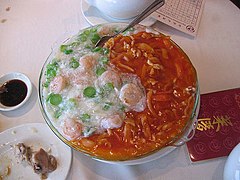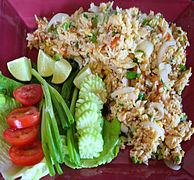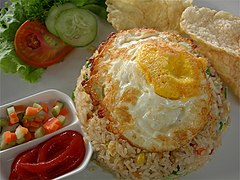Fried rice
 Thai-style seafood fried rice | |
| Alternative names | List
|
|---|---|
| Type | Khao phat Nasi goreng |
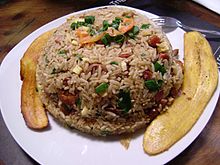
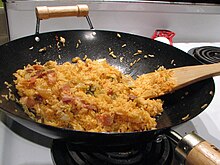
Fried rice is a dish of
Many varieties of fried rice have their own specific list of ingredients. In China, common varieties include
Fried rice is a common street food in Asia and other parts of the world. In some Asian countries, small restaurants, street vendors and traveling hawkers specialise in serving fried rice. In Indonesian cities it is common to find fried rice street vendors moving through the streets with their food cart and stationing it in busy streets or residential areas. Many Southeast Asian street food stands offer fried rice with a selection of optional garnishes and side dishes.
Preparation
History
The earliest record of fried rice is in the Sui dynasty (589–618 AD) in China.[2]
Varieties
East Asia
China
- Hokkien (or Fujian) fried rice (福建炒飯), a variation of Chinese fried rice, is from the Fujian region of China; it has a thick sauce poured and mixed over it which can include mushrooms, meat, vegetables, and other ingredients.
- Sichuan fried rice (四川炒飯) is a spicy stir-fried rice from Sichuan which uses doubanjiang chili sauce with garlic, green onions, and red onion.[3]
- Yin-yang fried rice (駌鴦炒飯) is topped with two different types of sauce, typically a savory white sauce on one half and a red tomato-based sauce on the other half. Elaborate versions use the sauces to create a yin-yang symbol.
- Yeung chow (or Yangzhou) fried rice(揚州炒飯) consists of generous portions of shrimp and scrambled egg, along with barbecued pork. This is the most popular fried rice served in Chinese restaurants, commonly referred to simply as "special fried rice" or "house fried rice".
Japan
- Chāhan (チャーハン) or yakimeshi (焼飯) is a Chinese-derived fried rice suited to Japanese tastes by the addition of katsuobushifor flavor, prepared with a variety of ingredients.
- Omurice is fried rice wrapped inside an egg omelette. The fried rice is generally mixed with a variety of vegetables and meat. Often a variant called "chicken rice" (チキンライス chikinraisu) is used. Ketchup or some other tomato sauce is added to make this.
Korea
- bap (cooked rice) with other ingredients in oil.[4] A wide range of fried rice dishes are common in Korean cuisine, often made with whichever ingredients are handy. In Korean restaurants, fried rice is a popular end-of-meal add-on.[5] After eating the main dishes cooked on a tabletop stove, cooked rice along with gimgaru (seaweed flakes) and sesame oilis often added directly into the remains of the main dishes, stir-fried, and browned.
- Kimchi-bokkeum-bap (김치볶음밥; lit. "kimchi fried rice") is a popular variety of bokkeum-bap, prepared with kimchiand a variable list of other ingredients.
Southeast Asia
Cambodia

- Bai cha (បាយឆា) is the Cambodian variation of fried rice and usually includes pork, sausages, eggs, garlic, soy sauce, and herbs.[6] There are numerous variations of the dish in Cambodia, including bai cha kapi (បាយឆាកាពិ) made with shrimp and shrimp paste (kapi).[7]
Indonesia, Malaysia, Singapore

- kecap/kicap manis) and ground shrimp paste. It is often accompanied by additional items such as a fried egg, fried chicken, satay, and condiments such as sambal, acar, and krupuk/keropok. It is endemic to Brunei, Indonesia, Malaysia, Singapore, and is also popular in the Netherlands.
- Nasi goreng jawa, which means "Javanese fried rice", commonly includes sambal ulek as a seasoning and has a spicy flavor.[8][9]
- Nasi goreng pattaya is Malaysian-style nasi goreng wrapped inside an egg omelette. The fried rice is generally mixed with a variety of vegetables and meat and garnished with tomato sauce. In Indonesia, the dish is called nasi goreng amplop.
- Nasi goreng ikan asin, is fried rice with salted fish.
- Sambal fried rice found in Singapore is a variation of fried rice made with sambal, a condiment based on chilis and belachan, derived from Indonesian and Malaysian influences.
- There is also a famous fried rice from Indonesian called "nasi goreng kambing" meaning "goat/lamb fried rice". It is made with several spices, such as bay leaves, cloves, cardamom, and cumin. It is accompanied with lamb, acar, and krupuk. It is derived from Arab influences.[10]
Myanmar
- Burmese fried rice (ထမင်းကြော်, htamin gyaw) normally uses Burmese fragrant short grain rice (rounder and shorter than other varieties). A popular plain version consists of rice, boiled peas, onions, garlic, and dark soy sauce. An accompanying condiment could be ngapi kyaw (fried fish paste with shredded flakes) and fresh cucumber strips mixed with chopped onions, green chili, and vinegar.
Philippines

- aligue (crab fat paste), which turns the dish a vivid orange-yellow. It can be combined with seafood like shrimp and squid and eaten as is, or eaten paired with meat dishes.[11]
- bagoong alamang(shrimp paste) as its main flavoring agent. Meat, scallions, as well as green mangoes are optionally additions.
- Java rice, also called "yellow fried rice", is a Filipino fried rice dish characterized by its yellow-orange color due to the use of turmeric or annatto. It is commonly seasoned with pimiento, bell peppers, paprika or tomato ketchup. It is usually eaten with chicken barbecue (inihaw) dishes.[12]
- Sinangág, also called "garlic fried rice", is a Filipino fried rice cooked by stir-frying pre-cooked rice with garlic. The rice used is preferably stale, usually leftover cooked rice from the previous day, as it results in rice that is slightly fermented and firmer. It is garnished with toasted garlic, salt, and black pepper. The rice grains are ideally loose and do not stick together.[14]
- Sinangág is rarely eaten on its own, but is usually paired with a "dry" meat dish like tapsilog breakfast and its derivatives.[14]
Thailand

Fried rice (
Vietnam


- Cơm chiên or cơm rang is a .


South Asia
India
- Fried rice is one of the most popular dishes of Indian Chinese cuisine in India.
- Curry fried rice is standard fried rice mixed with curry powder for a spicier flavor.
- Tava
Nepal
- Bhuteko bhat (भुटेको भात) is a Achar; However, curry and dhal may also be served alongside it.[17]
Sri Lanka

- Sri Lankan fried rice (Sinhala: ෆ්රයිඩ් රයිස්), (Tamil: வறுத்த அரிசி) is a Sri Lankan variation of the original Chinese version. However, basmati or other native varieties of rice are used and Sri Lankan spices are also added to it.[18][19]
- Nasi goreng (Sinhala: නාසි ගොරේන්) is a popular fried rice dish widely eaten throughout the country. It entered Sri Lankan cuisine through cultural influences from the Malay and Indonesian cuisines.[20]
Pacific
Hawaii
- Hawaiian fried rice is a common style of fried rice in Hawaii usually containing egg, green onions, peas, cubed carrots, and either Portuguese sausage or Spam, or both, and is sometimes available with kimchi added. It is normally cooked in sesame oil.
Americas
Arroz frito is a denomination used in the
- Bacon and egg fried rice[21]
Ecuador
- Chaulafan is the name for Chinese fried rice in Ecuador. In Ecuador and Peru, dark soy sauce is preferred in fried rice. Meats typically used are pork, beef, chicken or fish/seafood (e.g. shrimp).
Cuba

- Arroz frito (Cuban fried rice) is very similar to "special fried rice". It can be found alongside typical criollo dishes in many Cuban restaurants. This dish features ham, grilled pork, shrimp, chicken, and eggs, along with a variety of vegetables. Some restaurants add lechón (Cuban-style suckling pig), lobster tails, or crab. Chinese Cubans are responsible for the dish's introduction.
Dominican Republic
An estimated 30,000 people of Chinese origin live in the Dominican Republic. Migration from China began in the second half of the 19th century. Fried rice alongside fried chicken (chicarrón de pollo) has been the biggest influence. Dominican fried rice is known as chofán. The dish is made with leftover white rice, celery, peppers, onions, carrots, peas, soy sauce and ham, chicken, eggs or shrimp sautéed in vegetable oil.
Peru
- Arroz chaufa is a popular name for Chinese fried rice in Peru, belonging to the chifa kitchen. In Chile, it is called arroz chaufán. The most common varieties are made using the same ingredients used in China. Some exotic versions may use dried meat, beef tongue, alligator, or lizard in place of more traditional meats. In some regions, the rice is replaced with quinoa or pearled wheat, while in others the rice is mixed with noodles. Aeropuerto is a big Peruvian arroz chaufa dish containing fried noodles and many other additions.
Puerto Rico
- Arroz mamposteao is a kind of fried rice in Puerto Rico. It was brought to the island by Chinese immigrants and is usually made with leftover rice and typically Asian ingredients such as bean sprouts, ginger, garlic, soy sauce, combined with popular Puerto Rican ingredients such as red beans, sweet plantains, squash, bacon, longaniza, and variety of vegetables. Puerto Rican fried rice is usually garnished with sesame seeds, avocado, cilantro, cheese or aioli. Left over stew beans can also be added. The beans are typically stewed in sofrito, tomato sauce, spices, pork, potatoes and other ingredients.
Africa
Ghana
Ghanaian fried rice is one of the more contemporary dishes and can be found in almost every Ghanaian restaurant. It is usually made with Jasmine rice, long grain, or basmati rice. The rice is stir-fried with vegetables(carrots, spring onions, peas, green and red bell peppers), eggs, meats of choice(chicken, beef, shrimp), and spices like chili, curry powder, and salt. The sauces mixed with Ghanaian fried rice are usually soy sauce and chicken broth.
Nigeria
Nigerian fried rice is made with long-grain rice, diced fried cow liver (optional) or shrimp, protein ( chicken, pork, or shrimp), vegetables (such as carrots, peas, green beans, onions, and chillies), herbs and spices (such as thyme, pepper, and curry powder), and so on. This dish was created by the Yoruba people and spread as a Nigerian staple.
Tanzania
Tanzania fried rice is made with long-grain rice, protein (such as beef liver, chicken, or shrimp), vegetables (such as carrots, peas, green beans, onions, and chillies), herbs and spices (such as thyme, pepper, and curry powder), and so on.
Gallery
- Fried rice dishes
-
Ghanaian Fried rice
-
Beef fried rice topped with a sunny side up egg
-
Szechwan fried rice is an Indo-Chinese dish[22]
-
Cheolpan-bokkeum-bap on iron griddle
-
Korean fried rice
-
Fuk gin caau faan, Hokkien fried rice
-
Jyun joeng caau faan, Hong Kong-style "mandarin ducks" fried rice
-
Khao phat, Thai fried rice
-
Khao phat kaeng khiao wan, green curry fried rice
-
holy basil
-
Khao phat pu, Thai fried rice with crab meat
-
Nasi goreng with salted fish and egg
-
Nasi goreng istimewa, special fried rice
-
Javanese-Surinamese nasi goreng in The Netherlands
-
Nasi goreng pattaya, Malaysian omelette rice
-
Nigerian fried rice with fish, salad and steamed bean pudding
-
Omurice (Japanese omelette rice) with fried rice inside
-
Taiwanese fried rice
-
Filipinosinangág with cashews
-
Filipinolongganisa
See also
- Arroz a la valenciana
- Arroz con pollo
- Arròs negre
- Biryani
- Fried noodles
- Jambalaya
- Nam khao – a salad from Laos made with deep-fried rice balls and other ingredients
- Paella
- Pilaf
- Risotto
- Yam naem– a Thai salad prepared using fried curry rice and other ingredients
References
- ISBN 9781598849554.
- ^ "Chinese Fried Rice". iFood.tv.
- ^ "Szechuan Fried Rice". China Sichuan Food. 16 November 2014.
- ^ (in Korean) "볶음-밥". Standard Korean Language Dictionary. National Institute of Korean Language. Retrieved 4 March 2017.
- ^ Kim, Keith (2012-03-29). "10 of Seoul's Most Famous and Popular Galbi Restaurants". Seoulistic. Retrieved 4 March 2017.
- ^ Carter, Terence. "Cambodian Fried Rice Recipe – How to Make the Best Bai Cha". Grantourismo Travels. Retrieved 25 October 2019.
- ^ Dunston, Lara (14 September 2020). "Shrimp Fried Rice With Shrimp Paste Recipe for Cambodia's Bai Cha Kapi". Grantourismo Travels. Retrieved 7 January 2021.
- ^ "Resep Cara Membuat Nasi Goreng Jawa Pedas Lezat". fimela.com. September 9, 2017.
- ^ "Javanese Fried Rice - Kitchenesia". kitchenesia.grid.id.
- ^ "Nasi Goreng Kambing Ala Kebon Sirih".
- ^ "Crab Fat or Aligue Fried Rice". Kusina ni Teds. 3 July 2016. Retrieved 10 April 2020.
- ^ "How to Make Yellow Fried Rice (Java Rice)". Manila Spoon. Retrieved 8 January 2024.
- ^ "Morisqueta Tostada". Ang Sarap. Retrieved 6 January 2024.
- ^ a b Vanjo Merano (30 July 2014). "Sinangag Recipe". Panlasang Pinoy. Retrieved 8 December 2014.
- ^ Goyal Siraj, Ashima (2015-06-15). "Express Recipes: How to make Mumbai style Tawa Pulao". The Indian Express. Retrieved 2019-08-18.
- ^ Gomes, Michael (2019-01-03). "How about some street food for brunch?". Khaleej Times. Retrieved 2019-08-18.
- ^ "Bhuteko Bhat – We All Nepali". weallnepali.com. Retrieved 29 August 2015.
- ^ "Fried rice". wordpress.com. Retrieved 29 August 2015.
- ^ "Sri Lankan Food: 40 of the Island's Best Dishes". Migrationology.com/. Retrieved 4 January 2016.
- ^ Cassim, Aysha Maryam (17 August 2016). "ශ්රී ලාංකික ආහාර සංස්කෘතිය වර්ණවත් කළ පෙර අපර දෙදිග රජබොජුන්". roar.media (in Sinhala). Roar. Retrieved 16 June 2018.
- ^ "Bacon and Egg Fried Rice". Washington Post. Retrieved 2021-02-15.
- ^ "Schezwan fried rice recipe - How to make schezwan fried rice". 4 August 2015.



![Szechwan fried rice is an Indo-Chinese dish[22]](http://upload.wikimedia.org/wikipedia/commons/thumb/1/1e/Fried_rice_schezwan_style.jpg/243px-Fried_rice_schezwan_style.jpg)



